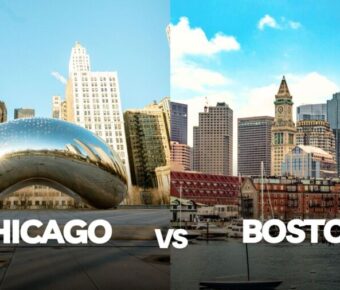
Split vs Makarska: 7 Key Differences Between Croatia’s Best Coastal Destinations
Croatia’s stunning Dalmatian coast offers two popular destinations that draw visitors year after year – Split and Makarska. These coastal gems each have their own unique charm and character.
Split offers more historical sites, activities, and year-round entertainment options compared to the seasonal beach town of Makarska. The ancient city walls and Diocletian’s Palace give Split a rich cultural backdrop, while its larger size means more shops, restaurants, and things to do in any season.
Makarska shines with its picture-perfect beaches nestled beneath the dramatic Biokovo mountains. The smaller resort town provides a more laid-back atmosphere with its pretty harbor promenade and crystal-clear waters. Its central location makes it perfect for day trips to nearby islands and coastal spots.
Contents
- Geographical Overview and Historical Value
- Location and Landscape of Split and Makarska
- Historical Sites and Significance
- Travel and Transportation
- Ferry Services and Coastal Routes
- Local Transport Options in Split and Makarska
- Transport from Split Airport to Makarska
- Accommodation and Leisure
- Hotels and Alternative Lodging
- Leisure Activities in Split and Makarska
- Beaches and Natural Attractions
- Famous Beaches and Their Facilities
- Natural Landscapes and Day Trip Destinations
- Culinary Journey
- Local Cuisine and Dining Experience
- Best Restaurants and Eateries
- Shopping and Amenities
- Grocery Stores and Local Markets
- Large Supermarkets and Shopping Centers
- Activities and Adventure
- Water Activities and Boat Trips
- Biking and Hiking Trails
- Adventure Bike Tour and Other Excursions
- Planning and Booking
- Making Travel Arrangements in Advance
- Booking Day Trips to Nearby Locations
- Local Insights
- Cultural Practices and Etiquette
- Weather Forecast and Best Time to Visit
- Frequently Asked Questions
- What are the main attractions to visit in Makarska compared to Split?
- How do travel times differ when getting from Split to Makarska by sea?
- Which destination offers better accommodation options for families, Split or Makarska?
- Where will I find more vibrant nightlife, in Makarska or Split?
- Are there any hidden gems to explore in Makarska that are akin to those in Split?
- What cultural experiences set Makarska apart from Split?
- More Travel Guides
Geographical Overview and Historical Value
Split and Makarska sit along Croatia’s stunning Dalmatian coast, offering different experiences for travelers. Split stands as a major cultural hub with deep historical roots, while Makarska shines as a scenic coastal resort town nestled between mountains and sea.
Location and Landscape of Split and Makarska

Split lies about 60 kilometers north of Makarska along the Adriatic coastline. The city spreads out from its ancient core, mixing modern urban areas with historic districts.
The natural harbor of Split played a key role in its growth as a major port city. Mountains provide a dramatic backdrop, while islands dot the sea ahead.
Makarska occupies a picture-perfect spot in a horseshoe-shaped bay. The striking Biokovo mountains rise up behind the town, creating a natural amphitheater effect.
A palm-lined promenade runs along Makarska’s waterfront, making it perfect for seaside walks. The town’s beaches rank among Croatia’s most beautiful.
Historical Sites and Significance

Split’s history spans more than 1,700 years. The UNESCO-protected Diocletian’s Palace forms the heart of the old town – a remarkable Roman complex where people still live and work today.
Ancient churches, medieval squares, and Roman ruins fill Split’s historic core. You’ll find history around every corner, from underground cellars to Jupiter’s Temple.
Makarska offers fewer historical attractions. The town developed as a modern tourist destination, though you can spot some Baroque buildings in its center.
The main square of Makarska features the 18th-century St. Mark’s Church. A Franciscan monastery houses a fascinating seashell museum, adding a unique cultural touch.
Travel and Transportation
Getting between Split and Makarska offers several convenient options by land and sea. Travelers can choose transportation methods that fit their schedule and budget while enjoying stunning coastal views.
Ferry Services and Coastal Routes

Kapetan Luka runs daily ferry service connecting Split and Makarska. The boat journey takes just over an hour and costs €10-16 each way.
The ferry ride provides amazing views of the Dalmatian coastline and nearby islands. Boats depart from the main ports in both cities.
Summer brings more frequent sailings, while winter schedules are more limited. It’s smart to book tickets ahead during peak tourist season.
Local Transport Options in Split and Makarska

Buses run frequently between Split and Makarska, with Search Flights, Hotels & Rental Cars offering competitive rates. The trip takes about 1 hour 20 minutes and tickets cost €7-11.
FlixBus operates 5 daily trips, while other companies like Promet Makarska run every 4 hours.
Taxis serve both cities for local trips. Split has more taxi options due to its larger size.
Both cities are walkable in their central areas. Bikes make a great option for exploring the coastal promenades.
Transport from Split Airport to Makarska

The journey from Split Airport to Makarska takes about 2 hours and 15 minutes. Several bus companies offer direct service from the airport terminal.
Booking tickets online saves time, especially during busy summer months. The bus stop is right outside arrivals.
Private transfers and taxis provide faster, more flexible options. These cost more but offer door-to-door service and air conditioning.
Shared shuttle services balance convenience and cost. They pick up from the airport and drop off at Makarska hotels.
Accommodation and Leisure
Split and Makarska offer distinct lodging styles and activities that cater to different types of travelers. Each destination brings unique advantages for visitors seeking places to stay and ways to spend their time.
Hotels and Alternative Lodging

Split features a mix of hotels and accommodations ranging from luxury waterfront properties to cozy guesthouses in the historic center. Many places sit within walking distance of Diocletian’s Palace and the main attractions.
Makarska’s accommodations tend to focus on beachfront locations, with numerous smaller hotels and apartment rentals offering sea views. The town has fewer high-end options compared to Split.
Both cities provide private rooms and apartments through local hosts. These options often give better value than hotels, especially for longer stays or family groups.
Leisure Activities in Split and Makarska

Split keeps visitors busy year-round with its blend of history and modern entertainment. The city offers guided walking tours, wine tasting, and sailing trips to nearby islands. Its promenade buzzes with cafes and shops.
Makarska shines as a beach destination. The town’s long pebbly beach stretches beneath the dramatic Biokovo mountains. Water sports like kayaking and parasailing are popular in summer months.
Split maintains an active nightlife scene throughout the year. Its restaurants serve fresh seafood and local dishes until late. Makarska’s entertainment scene focuses more on seasonal beach bars and casual dining spots.
The variety of daytime activities differs significantly. Split provides museums, galleries, and markets. Makarska centers on beach activities and coastal walks.
Beaches and Natural Attractions
Split and Makarska both offer amazing beaches and natural spots for visitors. The coastlines feature clear blue waters and stunning mountain backdrops that make swimming and sunbathing extra special.
Famous Beaches and Their Facilities

Makarska’s beaches are known for their perfect white pebbles and crystal-clear waters. The popular Buba Beach sits 20 minutes from town center and draws a younger crowd with its fun party atmosphere.
Most Makarska beaches have Blue Flag status, which means they meet strict standards for water quality and safety. Beach chairs cost about 8-10 euros per day at most spots.
Split’s Bacvice Beach stands out as the city’s most famous swimming spot. This shallow sandy beach gets packed with locals playing picigin, a unique ball game that started right here.
Natural Landscapes and Day Trip Destinations

The dramatic peaks of Biokovo Mountain rise behind Makarska, creating an amazing backdrop for photos. Hiking trails lead up the mountain for great views of the islands.
Split sits perfectly for day trips to natural wonders. A quick boat ride takes you to Brac Island, home to the famous Zlatni Rat beach in Bol. This V-shaped pebble beach changes shape with the winds and currents.
The pine forests along both coastlines provide nice shaded walks away from the summer heat. Many hidden coves and smaller beaches wait to be discovered by walking the coastal paths.
Both areas have great spots for snorkeling around the rocky parts of the beaches. The water stays crystal clear most of the year.
Culinary Journey
Both Split and Makarska offer amazing food scenes that showcase authentic Croatian flavors. These coastal gems serve fresh seafood, local wines, and traditional dishes that will make your taste buds dance.
Local Cuisine and Dining Experience

Split’s food scene mixes old-world charm with modern flair. The city’s restaurants serve fresh-caught fish, grilled meats, and local specialties like pašticada – a tender beef stew that’s perfect on chilly February nights.
Street food is big in Split. You’ll find tiny shops selling burek (flaky pastries) and fresh seafood sandwiches. The famous Green Market offers local produce, cheese, and olive oil.
Makarska keeps things more traditional. Small family-run restaurants (konobas) dot the waterfront. They serve grilled fish caught that morning, along with homemade wine and rakija.
Best Restaurants and Eateries

Split’s must-try spots:
- Zrno Soli: High-end seafood with harbor views
- Villa Spiza: Tiny local favorite with daily changing menu
- Bokeria: Modern twist on Croatian classics
Makarska’s top picks:
- Susvid: Fresh fish and spectacular sea views
- Restaurant Riva: Perfect for watching sunset over dinner
- Gastro Diva: Local ingredients with creative presentation
The dining atmosphere differs between the cities. Split’s restaurants tend to be busier and more varied. Makarska offers a quieter, more intimate experience with most places focused on seafood and traditional dishes.
Prices in Makarska are often lower than Split, especially during tourist season. Many restaurants in both cities offer early-bird specials and lunch deals.
Shopping and Amenities
Split offers a much wider range of shopping options compared to Makarska, with more year-round stores and diverse retail choices. Makarska’s shopping scene is more seasonal and focused on tourist needs.
Grocery Stores and Local Markets

Split’s Green Market(Pazar) stands as the city’s main fresh produce hub, bustling with local vendors selling fruits, vegetables, and regional specialties. The market opens daily from early morning until 2 PM.
Several small grocery stores dot Split’s old town, making it easy to grab essentials while exploring. Konzum and Tommy markets are scattered throughout residential areas.
City dwellers and tourists alike flock to the famous Split Fish Market (Peskarija) for fresh seafood caught that morning. The salty scent and animated atmosphere make it a must-visit spot.
Large Supermarkets and Shopping Centers

Split houses several modern malls, including City Center One and Mall of Split. These centers feature international brands, electronics stores, and food courts that stay open year-round.
Makarska’s retail options are more limited. The Spot Mall and Shopping Center St. Nikola provide basic shopping needs, but with fewer choices than Split’s larger venues.
Both cities have Lidl and Kaufland supermarkets on their outskirts. Split’s locations tend to be bigger and better stocked than those in Makarska.
The main shopping strip in Makarska runs along the seaside promenade, with tourist-focused shops that often close during off-season months.
Activities and Adventure
Split and Makarska both offer amazing outdoor activities for adventure seekers, with each destination bringing its own unique mix of land and sea experiences. Split stands out with year-round options, while Makarska shines during peak season.
Water Activities and Boat Trips

The crystal-clear Adriatic Sea creates perfect conditions for water sports in both locations. Split serves as a major hub for boat excursions to nearby islands, including beautiful boat tours to Hvar. Visitors can choose from speedboat tours, kayaking trips, and catamaran rentals.
Swimming spots dot the coastline near both cities. Makarska’s beaches provide excellent snorkeling opportunities, with plenty of hidden coves to explore.
Water skiing and jet skiing rentals are available from May through October in both destinations. Split’s larger harbor means more options for scheduling these activities.
Biking and Hiking Trails

Split’s surrounding area features well-maintained cycling paths suitable for all skill levels. The Marjan Hill trails offer stunning views over the city and islands.
Makarska’s location at the foot of Biokovo Mountain creates amazing opportunities for mountain biking and hiking. The paths range from easy coastal rides to challenging mountain ascents.
Bike rentals are readily available in both cities. Split maintains dedicated cycling infrastructure year-round, while Makarska’s trails are best explored during spring and fall.
Adventure Bike Tour and Other Excursions

Professional guides lead exciting bike tours from Split throughout the year. These trips explore ancient Roman roads, olive groves, and coastal pathways.
Rock climbing attracts thrill-seekers to both locations. Makarska’s proximity to Biokovo Mountain provides natural climbing walls, while Split offers indoor climbing options during the off-season.
Zip-lining adventures run near both cities. The Cetina River canyon near Split hosts popular zip-line courses with amazing views.
Planning and Booking
Planning trips to Split or Makarska takes careful consideration of timing, transportation, and activities. Both cities offer different experiences that need smart advance planning.
Making Travel Arrangements in Advance

Book flights to Split Airport for the easiest access to both destinations. Split sits just 30 minutes from the airport, while Makarska is about 1.5 hours away by car or bus.
Getting between cities requires some planning. Regular bus service connects Split and Makarska, with the journey taking roughly 1 hour and 15 minutes. Consider renting a car to explore the stunning coastal road at your own pace.
Accommodations fill up fast during peak season (July-August). Book hotels or apartments at least 3-4 months ahead for the best rates and availability. Split has more hotel options, while Makarska features many beachfront apartments.
Booking Day Trips to Nearby Locations

Both cities work well as bases for exploring the region. From Split, popular day trips include the UNESCO World Heritage site of Trogir and boat tours to nearby islands.
Makarska offers easy access to hiking trails on Biokovo Mountain. Many visitors take guided tours to Mostar in Bosnia and Herzegovina to see its famous bridge.
Book day trips through local agencies or your hotel’s tour desk. Popular excursions include:
- Island hopping to Korcula
- Wine tasting in Hvar
- Walking tours of Trogir
- Boat trips to secluded beaches
- Hiking adventures
Compare prices between different tour operators. Book popular trips at least 2-3 days in advance during busy periods.
Local Insights
Split and Makarska each offer unique cultural experiences and distinct weather patterns that shape daily life in these Croatian coastal gems. Knowing the local customs and climate helps visitors plan better trips and blend in with residents.
Cultural Practices and Etiquette

Croatians in both Split and Makarska value family time and relaxed meals. Locals eat dinner late, often around 8-9 PM.
Greetings are important – a simple “dobar dan” (good day) goes a long way when entering shops or restaurants.
People dress well in both cities. Smart casual is perfect for restaurants and evening walks along the seafront. Beach clothes should stay at the beach.
Coffee culture rules daily life. Morning coffee can last hours as friends chat and catch up. Don’t rush through your coffee – it’s a social ritual.
Tipping is common but modest – 10% is typical for good service.
Weather Forecast and Best Time to Visit

Peak summer temps in July and August hit 30-35°C (86-95°F). The sea stays warm enough for swimming from May through October.
Spring (April-May) brings mild temps around 20-25°C (68-77°F) with fewer crowds. Perfect for sightseeing and outdoor activities.
Winter stays relatively mild at 5-15°C (41-59°F). Many tourist spots close or reduce hours from November to March.
The bura wind can blow strongly in winter, especially around Split. Pack layers if visiting in cooler months.
Rainfall peaks in November and December. September offers warm seas and smaller crowds – an ideal time to visit both cities.
Frequently Asked Questions
Split and Makarska each offer unique experiences along Croatia’s stunning Dalmatian coast. These coastal gems attract different types of travelers based on their distinct features and activities.
What are the main attractions to visit in Makarska compared to Split?
Split stands out with Diocletian’s Palace, a UNESCO World Heritage site that forms the heart of its Old Town. The city mixes ancient Roman architecture with modern cafes and shops.
Makarska’s main draw is its long pebble beach backed by the dramatic Biokovo Mountains. The town features a pretty marina and a charming main square with historic buildings.
How do travel times differ when getting from Split to Makarska by sea?
The ferry ride from Split to Makarska takes about 1 hour during summer months. Boats run several times daily between May and October.
Private speedboat transfers cut the journey time to 30-40 minutes, depending on sea conditions.
Which destination offers better accommodation options for families, Split or Makarska?
Split provides more diverse lodging choices, from luxury hotels to apartments within the ancient palace walls. Many places offer family rooms and kid-friendly amenities.
Makarska specializes in beachfront hotels and family-run guesthouses. The smaller scale makes it easier for families to get around on foot.
Where will I find more vibrant nightlife, in Makarska or Split?
Split wins for nightlife variety with its mix of bars, clubs, and live music venues spread throughout the old town and along the Riva promenade.
Makarska’s nightlife centers around beach bars and seasonal clubs. The scene gets lively in summer but quiets down off-season.
Makarska’s St. Peter Peninsula offers secluded coves and walking paths most tourists miss. The local fish market provides an authentic morning experience.
What cultural experiences set Makarska apart from Split?
Summer festivals and klapa singing performances in the main square celebrate traditional Dalmatian folklore on the Makarska Riviera.
Local olive oil tastings and cooking classes showcase regional cuisine in intimate settings not found in bigger Split.



